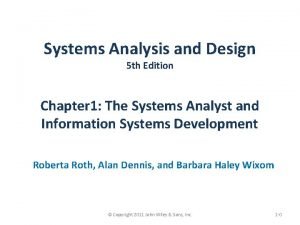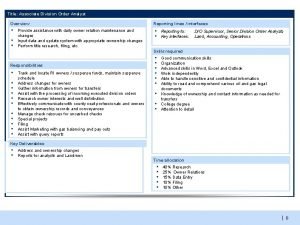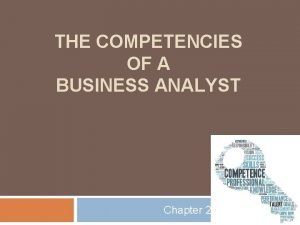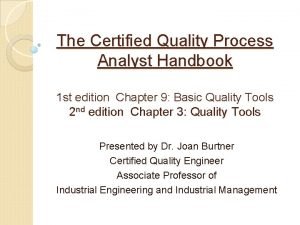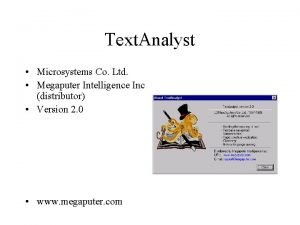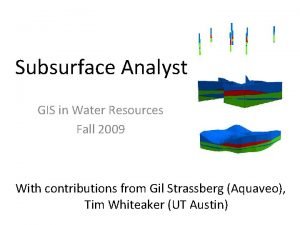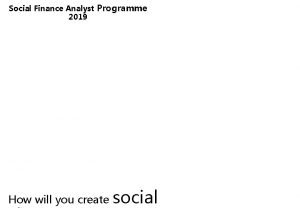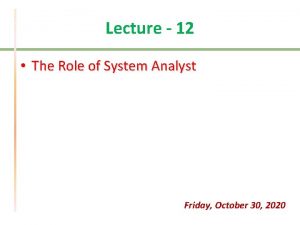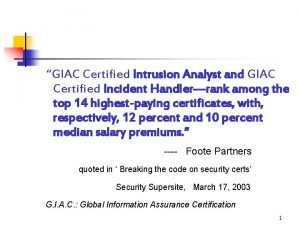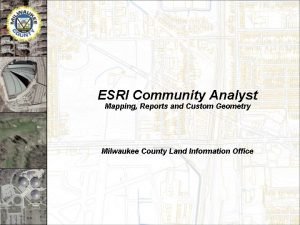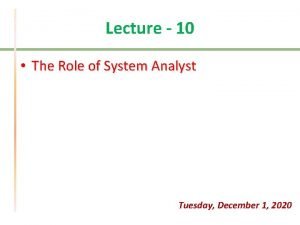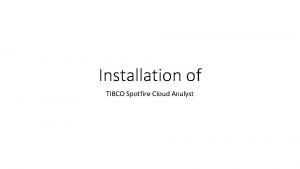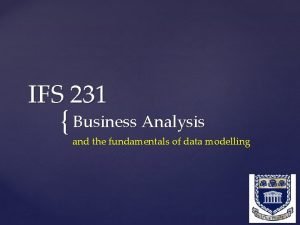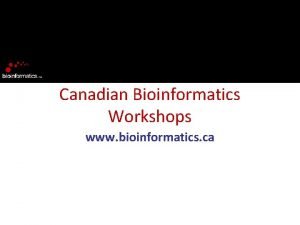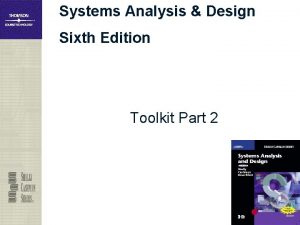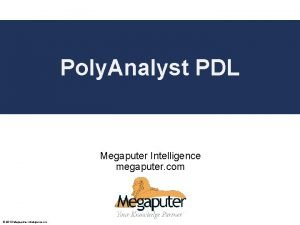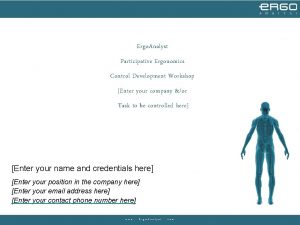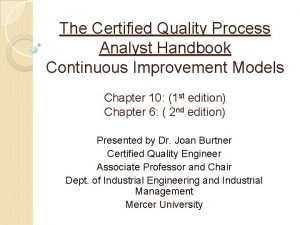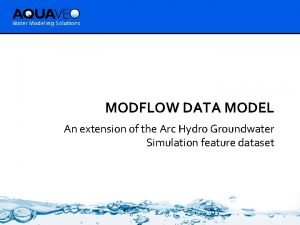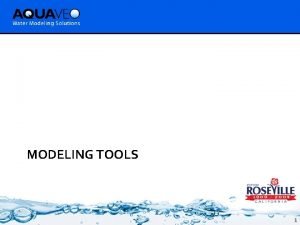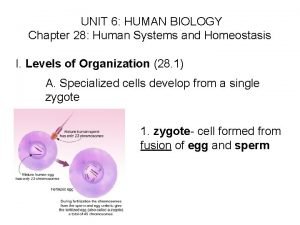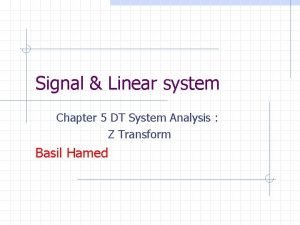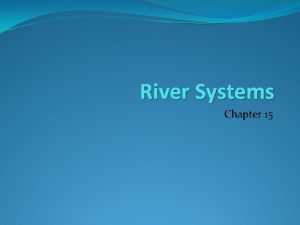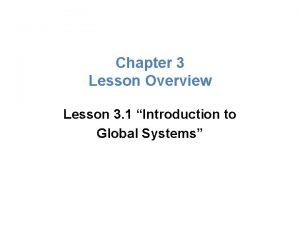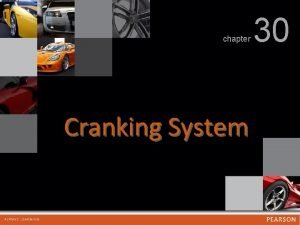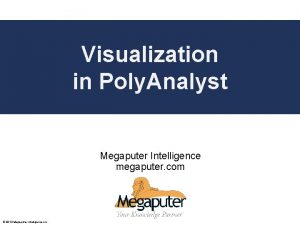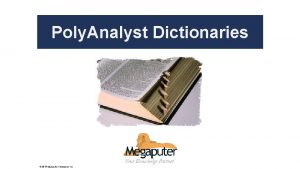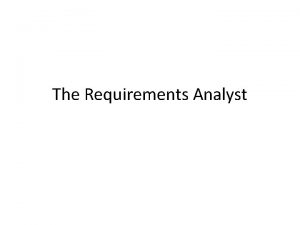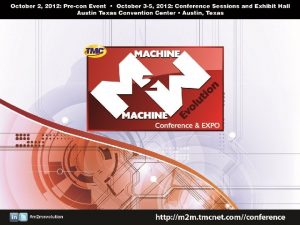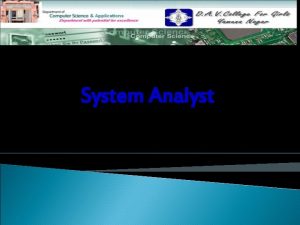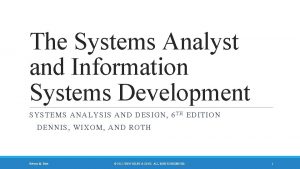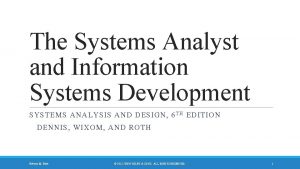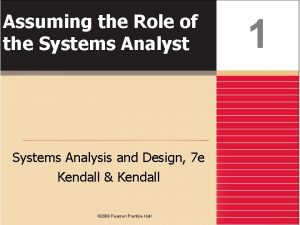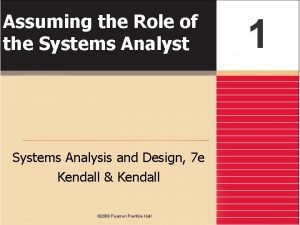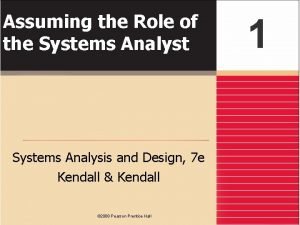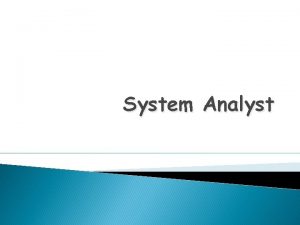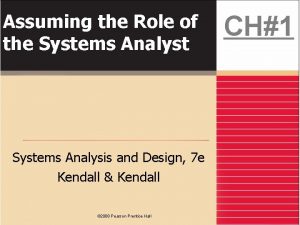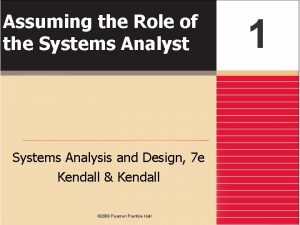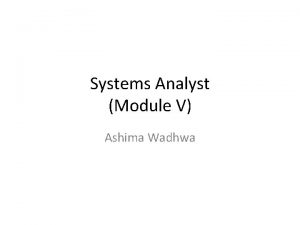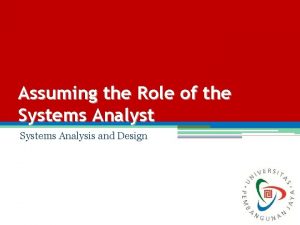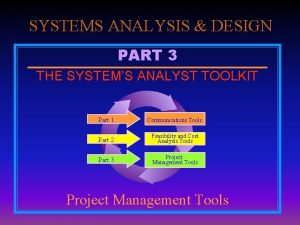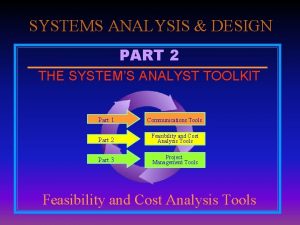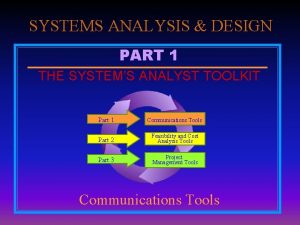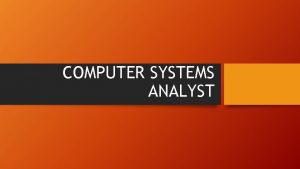Chapter 2 Succeeding as a Systems Analyst 2





















































- Slides: 53

Chapter 2 Succeeding as a Systems Analyst 2. 1 Copyright 2002 Prentice-Hall, Inc.

Learning Objectives ü ü ü 2. 2 Discuss the analytical skills, including systems thinking, needed for a systems analyst to be successful Describe the technical skills required of a systems analyst Discuss the management skills required of a systems analyst Identify the interpersonal skills required of a systems analyst Describe the systems analysis profession

Organizational Responsibilities in Systems Development l Systems Analysts work in teams, organized on a project basis. l Includes l Business Managers l IS Manager l Systems Analyst l Programmers l Other specialists l Users 1. 3

Organizational Responsibilities in Systems Development l Characteristics l Diversity of Successful Teams in backgrounds, skills and goals. l Tolerance of diversity, uncertainty. l Clear and complete communication l Must trust each other l Mutual Respect and putting one’s own goals and view secondary to those of the team l Reward team members that promotes shared responsibility and accountability within the team. l Effective Management of the Team including feasible and realistic work plan and schedule, monitoring progress, coordinating the project with its sponsors, allocating resources to the project

Analytical Skills for Systems Analysis l Four Sets of Analytical Skills Systems Thinking l Organizational Knowledge l Problem Identification l Problem Analyzing and Solving l 2. 10

Systems Thinking l System A system is an interrelated set of components with an identifiable boundary, working together for some purpose. OR l A system is an interrelated set of business procedures used within one business unit working together for a purpose l A system has nine characteristics l 2. 11


Systems Thinking l Characteristics of a System l l l 2. 13 Components: A system is made up of components. An irreducible part, which when aggregated with other components make up system. Also called subsystem. Interrelated Components: The components are interrelated. The function of one subsystem is dependent on the function of one or more subsystems. Boundary : A system has a boundary within which all of its components are contained and that establishes the limits of a system separating the system from other systems.

Systems Thinking l l l Purpose: All the components works together to achieve some overall goal or functions for the system. Environment : A system exists within an environment. Everything external to a system boundary that interacts with the system is an Environment. The Information System interacts with its environment to exchange data and information. Interfaces : Point of contact where a system meets its environment or where subsystem meet each other.

Systems Thinking l Interface functions Security: protecting the system from undesirable data l Filtering : removing unwanted data l Coding/decoding : outgoing and incoming messages l Detecting and correcting errors : in its interaction l with the environment l Buffering : providing a layer of slack to make the system and the environment compatible l Summarizing : transforming the raw data into more high level information

Systems Thinking l Characteristics of a System (contd. ) l l l Input : whatever a system takes from its environment in order to fulfill its purpose Output : Whatever a system returns to its environment in order to fulfill its purpose Constraints : A limit to what a system can do (in terms of capacity, speed or capabilities) and how it can achieve its purpose within its environment. Constraints can be imposed inside a system ( e. g. a limited number of staff) as well as outside the system i. e. environment ( e. g. due dates or regulations).


Systems Thinking l Important System Principles or Concepts that guide the design of IS l System’s relationship with its environment- a key aspect of a system. l l 2. 18 Open system interacts freely with its environment, taking in input and returning output. As the environment changes, an open system must adapt to the changes or suffer the consequences. All the business IS are open and constantly interacting with the environment. Closed systems does not interact with the environment. Changes in the environment and adaptability have no effect on the system.

Systems Thinking l Decomposition l l The process of breaking down a system into smaller components. These components may themselves be systems and can be broken down into their components as well. It helps the systems analyst to: l l Break a system into small, manageable and easier to understand subsystems Focus on one area of a system at a time making it easier to think how to modify that part independently of the entire system. Concentrate on component pertinent to one group of users Build different components at independent times by different people

Systems Thinking l Important l System Concepts (Contd. ) Modularity A direct result of decomposition l It refers to dividing a system into modules of a relatively uniform size l Modules can represent a system simply making it not only easier to understand but also easier to redesign or rebuild. l 2. 20

Systems Thinking l Important l Coupling l l System Concepts (Continued) Coupling is the extent to which subsystems are dependent on each other. Subsystems should be as independent as possible. If one subsystem fails and other subsystems are highly dependent on it, the others will either fail themselves or have problems functioning. Cohesion l Cohesion is the extent to which a subsystem performs a single function. Subsystems should be well differentiated and thus very cohesive.

Systems Thinking l Important System Concepts (Continued) l 2. 22 Logical System Description l Portrays the purpose and function of the system l Does not tie the description to a specific physical implementation e. g. basic components of the system , their relationship to each other, focusing on its function. l Example : The function of this college is the logical description. The function of each department and the relationship between the different departments.

Systems Thinking l Important System Concepts (Continued) l Physical System Description l Focuses on how the system will be materially constructed l e. g. It deals with the type of hardware, software and their distribution. Physical description of a computer would provide details on the construction of each subunit, design of ALU, the composition of memory etc.

Systems Thinking l Benefiting from Systems Thinking l l l 2. 24 Identification of problem area as a system involves recognition of each of the system’s characteristics e. g. components, boundary, input, output, environment etc. The S. A. is able to know the various characteristics of a problem area for which he wants to develop a system. Visualizing a set of things and their interrelationships as a system allows you to translate a specific physical situation into more general abstract terms, which helps us to think about the essential characteristics of a specific situation so that we can manipulate the abstract system without disrupting the real situation.

Systems Thinking l Applying Systems Thinking to Information Systems l l l 2. 25 Information systems are subsystems in larger organizational systems, taking input from and returning output to their organizational environment. Data flow diagrams can be used to represent information systems as systems, showing all the seven characteristics. Other two characteristics - Purpose and Constraints are difficult to illustrate and therefore must be documented.

Symbols used in Data flow diagrams Source or Sink D 1 Data Store Process Data flow The information system is depicted as a data flow diagram.

Example : Hoosier Burger’s Customer Order System l Hoosier Burger uses an information system known as Customer Order Information system which is used to keep a track of how much goods (burgers etc. ) were sold and the stock position of the goods in the Store. l The customer, acting as the source places the food order to the system. l The system is divided into four functions or processes. l Receive and Process : It receives the customer orders given by the customer and outputs the l Kitchen order data l receipt data l Goods sold data l Inventory data

Example : Hoosier Burger’s Customer Order System l The receipt goes back to the customer. l The kitchen order goes to the kitchen which act as an environment i. e. sink, Goods sold data generated Updates GOODS SOLD DATA FILE Inventory data generated also Updates INVENTORY DATA FILE Management Reports are produced for the Restaurant manager based on the inputs i. e. updated GOODS SOLD DATA and updated INVENTORY DATA. l l l


Hoosier Burger’s Customer Order System (Logical Description) l Logical System: It focuses on the flow and transformation of data. l Components (logical): l Process customer Food order l Update goods sold file l Update inventory file l Produce Management Reports l Boundary: l Shown by the dotted line l Input: l Customer order l

Hoosier Burger’s Customer Order System (Logical Description) l Output: l l A receipt for the customer A Kitchen order Management Reports Intermediate outputs l l l Goods sold data Inventory data etc. Purpose: l General purpose: To facilitate customer orders, monitor inventory and generate reports l Specific Purpose: To improve the efficiency of the restaurant’s operations.

Hoosier Burger’s Customer Order System (Physical Description) l Hoosier Burger Customer order system is a physical system that takes input, processes data, and returns output. The physical system consists of a computerized cash register that a clerk uses to enter a customer order and returns a receipt to the customer. Another piece of paper, the kitchen order is generated from the printer in the restaurant kitchen. The cash register sends data on the order about goods sold and inventory to a computer in Hoosier Burger’s office, where computer files on goods sold and inventory are updated by applications software. Other application software uses data in the goods sold and Inventory files to generate and print reports on a laser printer in the office.

Organizational Knowledge l l l 2. 33 Understanding of how organizations work Knowledge of specific functions and procedures of organization and department How work officially gets done in a Particular Organization Internal politics of the organization Understanding the Organization’s Competitive and Regulatory Environment Understanding the Organizational Strategies and Tactics

Problem Identification Problem: Difference between an existing situation and a desired situation l Problem Identification is process of defining differences l Differences are defined by comparing the current situation to the output of a model that predicts what the output should be l Problem Solving is the process of finding a way to reduce differences l 2. 34

Problem Analyzing and Solving Once a problem has been identified, the SA must analyze (finding more about the problem) the problem and determine how to solve it. l This approach for analyzing and solving problems as described by Simon has four Phases l l Intelligence l l Design l l 2. 35 Alternatives are formulated Choice l l All information relevant to the problem is collected Best alternative solution is chosen Implementation l Solution is put into practice

Technical Skills for Systems Analysis Technical skills are required by SA, not only to perform tasks assigned to him but also to communicate with other people with team members. l Constant re-education is necessary as technology changes rapidly l Activities to keep skills up-to-date l l 2. 36 Read Trade publications Join Professional societies Attend classes or teach at a local college

Technical Skills for Systems Analysis l Activities (contd. ) to keep skills up-to-date Attend any courses or training sponsored by organization l Attend professional conferences, seminars and trade shows l Regularly browse Websites, focusing on industry news l Participate in new groups and conferences on national or international network l

Technical Skills for Systems Analysis l Understanding of a wide variety of technologies is required l l l l 2. 38 Microcomputers, workstations, minicomputers and mainframe computers Programming languages Operating systems Database and file management systems Data communication standards Systems development tools and environments Web development languages and tools Decision support system generators

Management Skills for Systems Analysis l Management skills are very important for anyone in a leadership role. An Analyst should need to know how to manage her own work or how to use organizational resources in the most productive ways possible. Four categories of Management skills l l 2. 39 Resource Management Project Management Risk Management Change Management

Resource Management l Systems analyst needs to know how to obtain and work effectively with resources (such as system documentation, IT, people and money) of an organization. Includes the following capabilities l l l 2. 40 Predicting resource usage Tracking and accounting for resource consumption Learning how to use resources effectively. Evaluating the resource quality Securing resources from abusive use Relinquishing resources when no longer needed

Resource Management l Most important resource is people. l A team leader must learn how to best utilize the particular talents of other team members. l She must also be able to delegate responsibility, allowing people to do the tasks they have been assigned to.

Project Management l Two Goals l l Prevent projects from coming in late Prevent projects from going over budget Assists manager in keeping track of project’s progress. l Consists of several steps l l l 2. 42 Decomposing project into independent tasks Determining relationships between tasks Assigning resources and personnel to tasks It’s goal is also to manage people working on the project by motivating people at work together and instill a sense of trust and interdependence among them.

Project Management l Assists Managers in managing vendors and contractors working on the project. Very well specified contracts, defining what is expected and when. l Explicit sanctions for non performance l Involving relationship Managers, acting as a liaison between the firm and the contractor. They can sense trouble before it happens and works with both the parties. l

Risk Management l Ability to anticipate what might go wrong in a project l Minimize the occurrence of risk and/or l Minimize damage that might result l Placement of resources ( such as people), where they can do the most good l Prioritization of activities to achieve greatest gain 2. 44

Change Management l Ability to assist people in making a smooth transition to a new system, giving up their old ways of doing tings and accepting new ways. 2. 45

Interpersonal Skills for Systems Analysis l Mastery of interpersonal skills is paramount to success as a Systems Analyst l Four types of skills: Communication skills l Working alone and with a team l Facilitating groups l Managing expectations l 2. 46

Communication Skills Ability to communicate clearly and effectively with users, other IS professionals, management. l Effective communication helps to establish and maintain good working relationships with clients and colleagues l Communication Skill improve with experience l Three types used by Systems Analyst l Interviewing and Listening l Questionnaires l Written (memos, reports) and Oral (phone calls, face to face conversation) and Visual (presentations slides, diagrams) l 2. 47

Interviewing and Listening l Means to gather information about a project l Listening to answers is just as important as asking questions l Effective listening leads to understanding of problem and generates additional questions that may be even more revealing and probing. 2. 48

Written and Oral Presentations Used to document progress of project and communicate this to others l Written Communication takes several forms: l l l l 2. 50 Meeting agenda Meeting minutes Interview summaries Project schedules and descriptions Memoranda requesting information, an interview, participation in a project activity, or the status of a project. Requests for proposals from vendors and contractors Oral presentations

Steps to Improving Communication Skills l Take every opportunity to practice l l l Conduct a training class Volunteer to speak Participate in Toastmasters, to improve oral communication skills. Videotape presentation and do a self-appraisal of your skills l Make use of college writing centers l Take classes on business and technical writing l 2. 51

Working Alone and with a Team l Working alone on certain aspects of project involves organizing and managing: l l l Time ( schedule) Commitments Deadlines Team work involves establishing standards of cooperation and coordination that guide their work l Table 2 -2 presents characteristics of a highperformance team l 2. 52

Characteristics of a high-performance team Shared vision or goal Sense of team identity Result driven structure Competent team members Commitment to team Mutual trust on each other

Characteristics of a high-performance team Interdependence among team members Effective Communication Sense of autonomy Sense of Empowerment Small team size High level of enjoyment

Facilitating Groups l l l 2. 55 Involves guiding a group without being a part of the group Useful skill for sessions such as Joint Application Development (JAD) Specially trained to facilitate the groups, to help them work together, and to help them to resolve conflicts and achieve their goals. Facilitator has to remain unbiased. lists guidelines for running a successful meeting ( refer to fig 2. 9 page 49)

Managing Expectations Managing expectations is directly related to successful system implementation l Skills for successful expectation management l l l 2. 56 Understanding of technology and what it can do Understand the workflows that the technology will support and how the new system will affect them Ability to communicate a realistic picture of new system to users Effective education of management and users throughout systems development life cycle

Systems Analysis as a Profession l Standards have been established for education, training, certification and practice l Several aspects: Standards of Practice l Ethics l Career Paths l 2. 57

Standards of Practice l Endorsed Development Methodology l l l Approved Development Platforms l 2. 58 Specific procedures and techniques to be used during development process Promote consistency and reliability across all of an organization’s development projects Organizations standardize around a specific platform, sometimes tied to development methodology

Standards of Practice l Standardization l of Roles are becoming better defined across organizations l Development of a Common Language Common programming languages l Common modeling languages, such as Unified Modeling Language (UML) l 2. 59
 Systems analyst career progression
Systems analyst career progression Talent analyst emsi
Talent analyst emsi Division order analyst
Division order analyst Competencies of a business analyst
Competencies of a business analyst Certified quality process analyst
Certified quality process analyst Megaputer competitors
Megaputer competitors Subsurface analyst
Subsurface analyst Social finance analyst programme
Social finance analyst programme Shell lube analyst
Shell lube analyst Visible analyst
Visible analyst Multifaceted role of system analyst
Multifaceted role of system analyst Analyst hierarchy
Analyst hierarchy Giac certified intrusion analyst
Giac certified intrusion analyst Esri community analyst
Esri community analyst Talent analyst emsi
Talent analyst emsi Business analyst project case study
Business analyst project case study T shaped business analyst
T shaped business analyst Interpersonal skills of system analyst
Interpersonal skills of system analyst Spotfire cloud
Spotfire cloud Interpersonal skills of system analyst
Interpersonal skills of system analyst Cost analyst
Cost analyst Role of system analyst
Role of system analyst Cost analysis requirements description
Cost analysis requirements description Tony a data analyst for a major casino
Tony a data analyst for a major casino Business acceptance analyst
Business acceptance analyst Ifs business analyst
Ifs business analyst Mzmine
Mzmine Visible analyst case tool
Visible analyst case tool European federation of financial analysts societies
European federation of financial analysts societies Enagic tcpa settlement
Enagic tcpa settlement Pdl training
Pdl training Megaputer alternatives
Megaputer alternatives Ergo analyst
Ergo analyst Certified quality process analyst
Certified quality process analyst Modflow analyst
Modflow analyst Gms groundwater
Gms groundwater Deloitte forensic technology
Deloitte forensic technology Poly analyst
Poly analyst Decision support systems and intelligent systems
Decision support systems and intelligent systems Engineering elegant systems: theory of systems engineering
Engineering elegant systems: theory of systems engineering Embedded systems vs cyber physical systems
Embedded systems vs cyber physical systems Engineering elegant systems: theory of systems engineering
Engineering elegant systems: theory of systems engineering Chapter 28 human systems and homeostasis
Chapter 28 human systems and homeostasis Signals and systems oppenheim solutions chapter 5
Signals and systems oppenheim solutions chapter 5 Chapter 15 river systems answers
Chapter 15 river systems answers Functions of an information system
Functions of an information system Chapter 11 lubrication systems answer key
Chapter 11 lubrication systems answer key Levels of ecological organization
Levels of ecological organization Chapter 10 ignition systems
Chapter 10 ignition systems Lower court
Lower court Chapter 2 economic systems and decision making answer key
Chapter 2 economic systems and decision making answer key Section 38-1 food and nutrition
Section 38-1 food and nutrition Chapter 30 engine starting systems
Chapter 30 engine starting systems Chapter 8 securing information systems
Chapter 8 securing information systems
